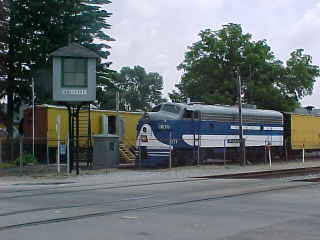
Knowing that this day, Friday, of the 2006 National Railway Historical Society convention would be a day of seminars, Board of Directors meetings and the NRHS membership meeting, all occuring at the Holiday Inn, I set up a visit for Chris Parker and I at the Mad River and NKP Museum in Bellevue and were expected there at noon. I researched some other rail activities along the way and some of the local Amish would provide others. Sleeping in this morning and after our now usual continental breakfast, we departed the Knights Inn at 7:53 AM and drove north on Interstate 77 to beyond Dover. At Strasburg, we took US 250 west to Ohio 93 then north to our first stop at Brewster, home of the Wheeling & Lake Erie Railroad.
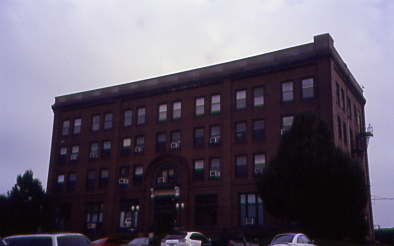
The four-story Wheeling & Lake Erie Station and railroad offices built in 1914 and commonly known as The Brick, or the largest skyscraper in Brewster. I went inside and asked if we could see the shops and was told it was okay but to be quick and stay off the tracks. With directions, we drove over to the shops.
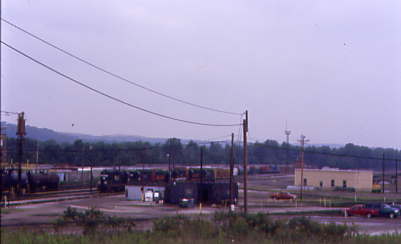
An overview of the yard and fuelling pads.
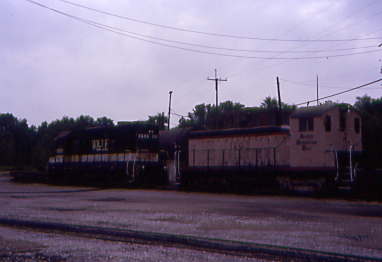
Akron Barberton Belt SW1200 1203, ex. lease to Nimisila and Tuscarawas Railroad 1203, exx. Norfolk and Western 3375, exx. Wabash 3375, nee Wabash 375 built by Electro-Motive Division in 1954 and Wheeling and Lake Erie GP35 2699, , nee Southern 2699 built by Electro-Motive Division in 1965.
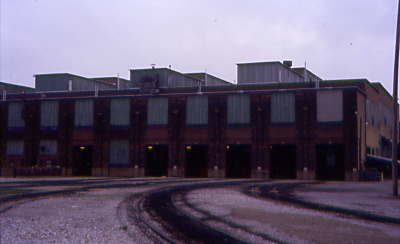
The Brewster Shops. Both the historic company and the current regional railroad, Wheeling and Lake Erie, began producing locomotives at its Brewster shops in 1910, and boasted one of the finest steam locomotive producing facilities in the country. Over the years, the WLE built and rolled boilers and erected fifty of their own steam engines, a feat never tried by many larger and more famous railroads. The shops continue to perform contract repairs, upgrades and fabrication of locomotives and freight cars to this day.
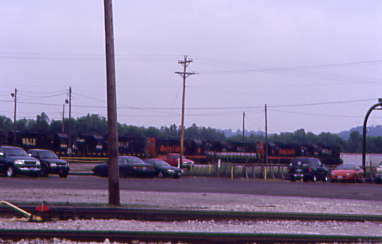
A look across at locomotives waiting for their next assignment. With that completed we departed Brewster and drove north on Ohio 93.
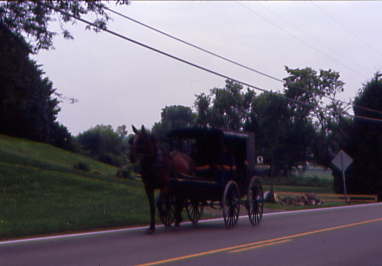
Just north of town, what should be coming down the road, but an Amish horse and buggy. After a semi truck went flying by them, I snapped a picture and all the Amish then smiled at me and waved. Chris Parker wanted to see more of this type of activity, but I advised him to be patient and we would sometime later today. We drove Ohio 93 north to US 30, the Lincoln Highway, and turned left onto Ohio 57, and our next stop at the Orrville depot.

Pennsylvania Railroad caboose 477828, built by the railroad in 1942, tower and depot.
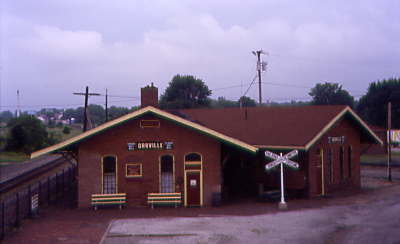
The Orville Cleveland, Akron and Columbus Railroad and Pittsburgh, Fort Wayne, and Chicago Railroad station built in 1868, as seen from the top of the tower steps.
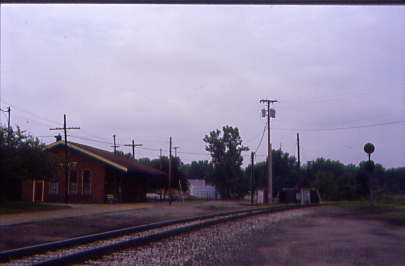
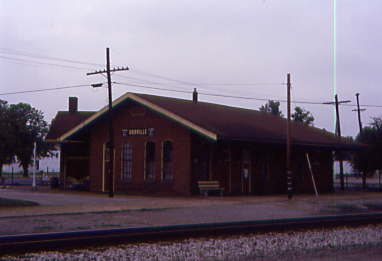
The west side of the station, home of the Orrville Railroad Heritage Society. The new W&LE bought these tracks from Norfolk Southern in the early 1990's, when the new W&LE was established.
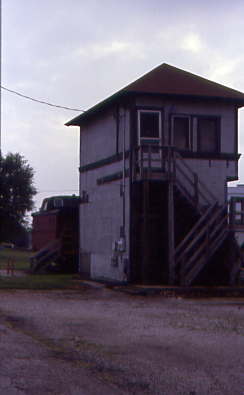
The former Pennsylvania Railroad Orrville interlocking tower, which controlled train movements along the city's two Pennsylvania Railroad mainlines, the Cleveland, Akron & Columbus and the Pittsburgh, Fort Wayne & Chicago and the busy train yard. The Pennsy had hundreds of towers like the one along its mainlines to control the movement of trains. Now they are all but gone, replaced by the two-way radios, cell phones and the Internet. Built in February 1899, Orrville's tower is one of very few to be preserved. After the Pennsylvania Railroad became part of Penn Central and later Conrail, the lines through Orrville were downgraded and many of their trains moved to other routes. The railroad was removing all the towers and Orrville Railroad Historical Society stepped in and saved the Orrville tower, moving it across the tracks to the ORHS property next to Union Station.
Satisfied with our finds, we continued north on Ohio 93 to Medina, where we turned left onto Ohio Highway 18 and came upon a grade crossing and two surprises.
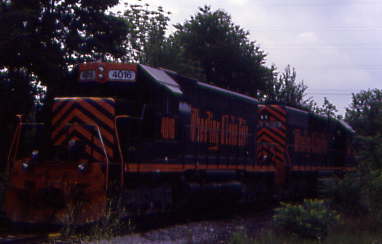
Wheeling and Lake Erie SD40-3 4016, ex. Union Pacific SD40 4016, exx. Missouri Pacific 3016, nee Missouri Pacific 716 built by Electro-Motive Division in 1967 and Wheeling and Lake Erie SD40-3 3016, nee Union Pacific 3016 built by Electro-Motive Division in 1966, awaiting their next assignment.
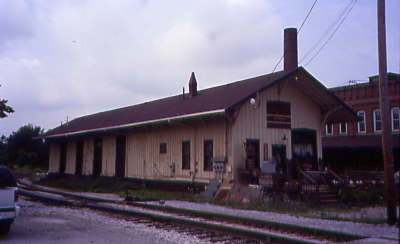
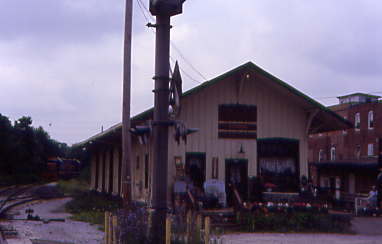
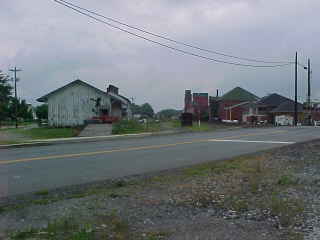

The freight station of the Cleveland, Lorain and Wheeling Railroad (a predecessor of the Baltimore and Ohio) built in 1900. We continued west on Ohio Highway 18 and in Wellington, stopped at Certified Gas and Food for snacks and drinks. This location was right next to the double-tracked CSX mainline to Cleveland.
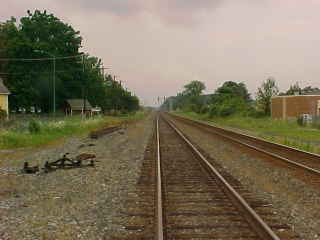
We crossed the CSX mainline through Wellington and just west of town we came to our next stop, the Lorain & West Virginia Railroad.

The station sign in front of the Lorain & West Virginia Railroad, a scenic railway located in Lorain County originally built to serve the heavy industries in Lorain. We offer seasonal train rides with historical 1950's era equipment from our train depot in Wellington. Organized in 1979, the non-profit Lake Shore Railway Association was formed to try and save the Lorain & West Virginia Railway from abandonment. Since that time we have purchased approximately 20 of the original 25 miles of that railroad. Operations began in 1993, and we have currently rehabbed the southern six miles of track, with hopes of continuing northward.

Overview of the station area.
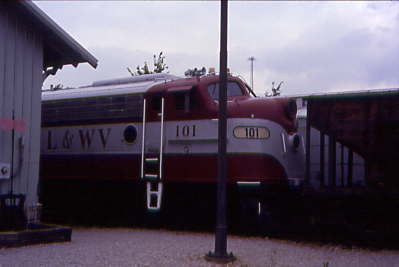
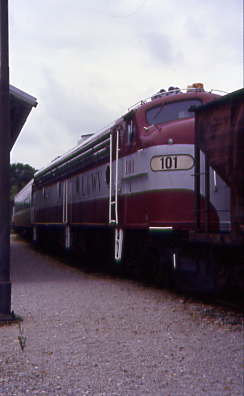
Lorain and West Virginia E8A 101, ex. Wisconsin and Southern 801, exx. Metra 522, nee Chicago and North Western 5021B built by Electro-Motive Division in 1950. It was acquired by the railroad in 1997 then was repainted and upgraded for high speed operation in 2002.

Lorain and West Virginia coach 2932, nee Long Island Railroad coach 2932 built by Pullman-Standard in 1956.
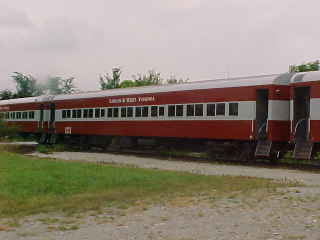
Lorain and West Virginia coach 2919, nee Long Island Railroad coach 2932 built by Pullman-Standard in 1955.
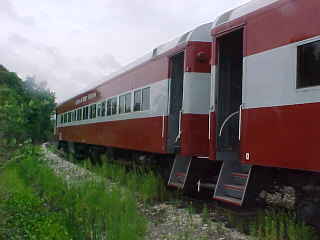
Lorain and West Virginia coach 2938, nee Long Island Railroad coach 2932 built by Pullman-Standard in 1956.
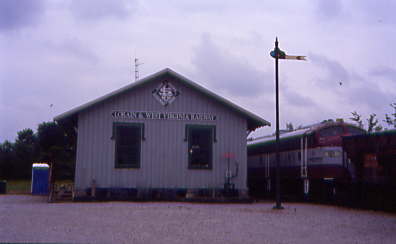
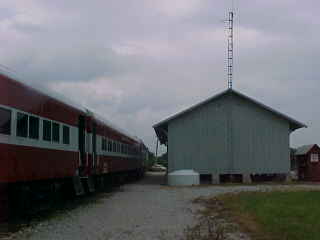
The Lorain and West Virginia station built in 1853 which is from Oberlin and was the original Toledo, Norwalk and Cleveland Railroad building. That railway began operations in northern Ohio and a series of mergers in 1869 resulted in the TN&C becoming part of the Lake Shore & Michigan Southern. Oral tradition has it that the contractor found a 1853 penny placed in one of the rafters of this building when it was disassembled for moving, which leads us to believe that at least part of the building was constructed at that time. The depot was threatened with demolition in the 1990's and rescued later that decade by a combined effort of the Lake Shore Railway Association and the Nordstrom Foundation. It was disassembled and rebuilt at Wellington piece-by-piece.
We continued our westward drive on Ohio Highway 18 to Norwalk, where we rejoined US 240 West the rest of the way to Bellevue and drove through town looking for the museum's blue sign, which we could not find but turned around and saw one which led us to the museum.
Mad River and NKP Railroad MuseumOne of the earliest railroads that ran through Bellevue in 1839 was the Mad River & Lake Erie Railroad and the first engineer of the "Sandusky", Thomas Hogg. The Mad River & NKP Railroad Society, a non-profit organization, chose this as part of our name when we formed. In 1976 we opened the museum as a lasting bicentennial project. Henry Flagler, who built the Florida East Coast Railroad once lived on the property where the museum is now located.
NKP is the AAR reporting mark for the Nickel Plate Road (New York, Chicago & St. Louis Railroad Company) which ran through Bellevue from 1882 until 1964 when it merged with the Norfolk & Western Railway. Bellevue was a hub for the Nickel Plate operations and a division point for the railroad's Buffalo to Chicago route. Bellevue housed the principal classification yards, the largest roundhouse in the system, all maintenance of way equipment for the road, the principal icing station, an engine terminal for both diesel and steam, headquarters of the general superintendent, and facilities that were used by four of the Nickel Plate's divisions.
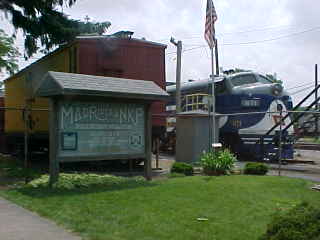
We parked then started to explore the outside exhibits.
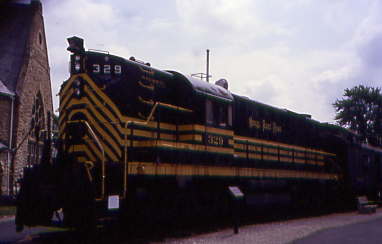
Nickel Plate Road RSD-12 329, built by American Locomotive Company in 1957.
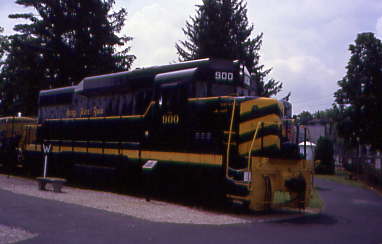
Nickel Plate Road GP30 900 built by Electro-Motive Division in 1962.

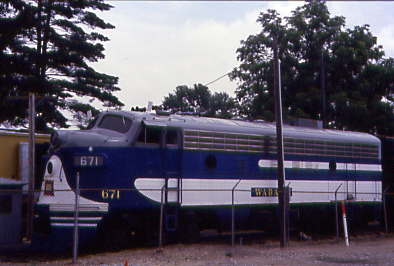
Wabash F7A 671, nee Wabash 1162, built by Electro-Motive Division in 1951.
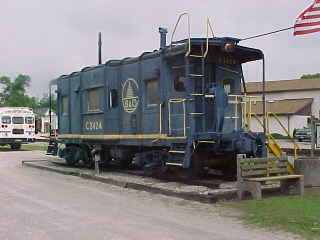
Baltimore and Ohio caboose C2424 built by the railroad in 1941.
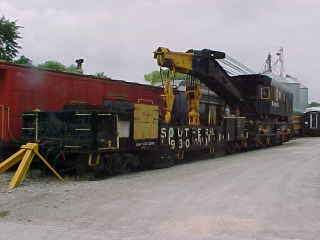
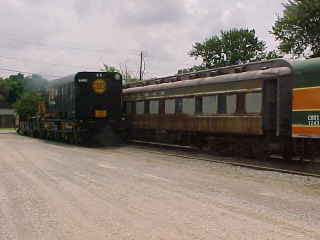
Norfolk and Western wreck crane 514900, nee Norfolk and Western 4966, built by Industrial Works in 1933.
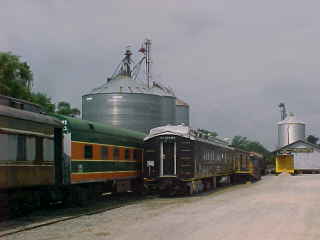
Museum scene.
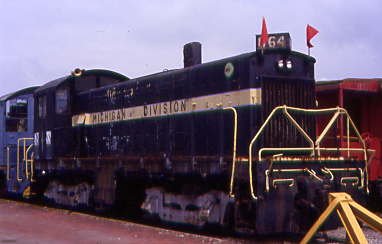
Northstar Steel Cargill Michigan Division S-5 864 built by American Locomotive Company in 1954.
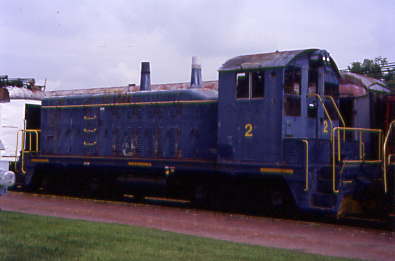
New Jersey Indiana & Illinois NW2 2, ex. Wabash 100, nee Indiana Northern 100, built by Electro-Motive Division in 1948.
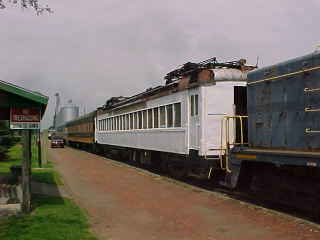
Erie-Lackawanna multiple unit 3545, nee Delaware, Lackawanna and Western 2545 built by Pullman and General Electric in 1930.
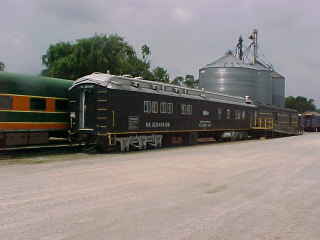
Nickel Plate diner 104 built in 1927 and converted to Norfolk Southern maintenance-of-way car 920494, built by Pullman in 1927.
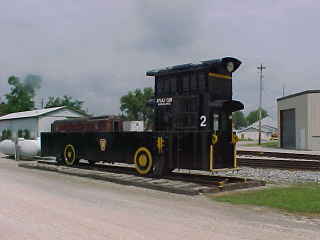
Pennsylvania Railroad 45 ton side arm pusher locomotive 2 built by Atlas Car in 1920 and used on the coal docks in Sandusky.
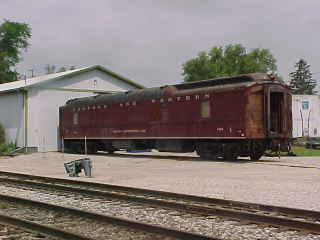
Norfolk and Western instruction car 402, nee Norfolk and Western baggage car 1300 built by Pressed Steel in 1913.
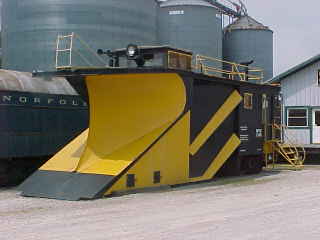
New York Central snowplow X665 built by Russell in 1943.
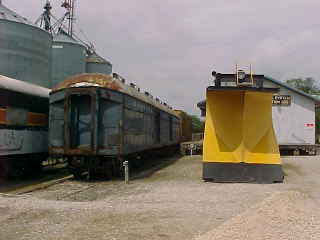
Museum scene.
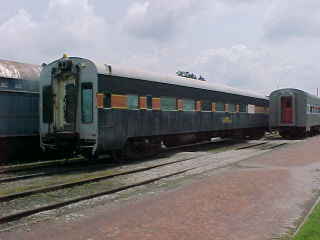
Amtrak 6 double bedroom-lounge-buffet 3226 "Sea Island Beach", ex. Seaboard Coast Line 6606, nee Atlantic Coast Line "Sea Island Beach" built by American Car and Foundry in 1949.

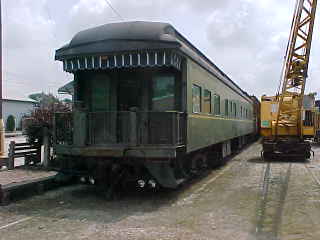
Penn Central heavyweight observation car 7, ex. Penn Central 11, exx. New York Central 8, nee New York Central 1, built by Pullman in 1927 and formerly owned by Ted Church.
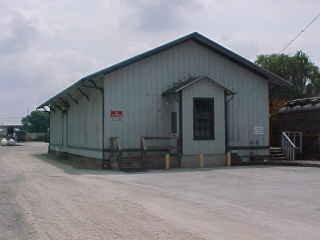

The Toledo, Norwalk & Cleveland, later New York Central, freight house built in 1862 and was a shipping and receiving location for many years before purchased by the museum in 1984.
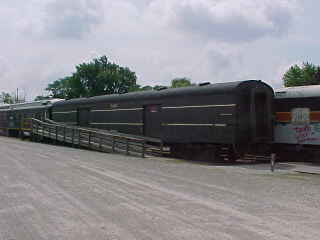
New York Central baggage car 9110 built by American Car and Foundry in 1946.
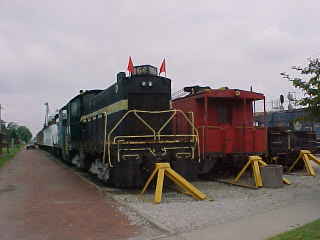
Another museum scene.

Mad River and NKP Museum 6-5-3 sleeper 1384 "Lewis and Clark Pass, exx. Amtrak 2450 1972, exx. Burlington Northern 1384 1970, nee Great Northern 1384 "Lewis and Clark Pass", built by Pullman-Standard in 1950. It was used on the original Empire Builder.
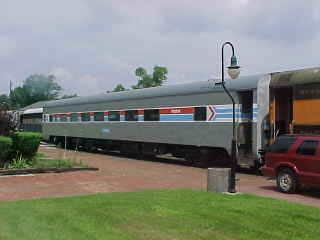
Amtrak 56-seat coach 5688, ex. Auto-Train Corporation 560 "Prairie Rose", nee Illinois Central 2640, built by Pullman-Standard in 1947.
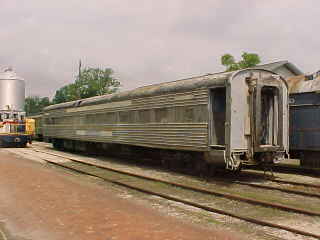
East Jordan and Southern coach-lounge 6007, ex. VIA Rail 156, exx. VIA 4119, exxx. Amtrak 6007, exxxx. Amtrak 4830, exxxxx. Amtrak 4401, exxxxxx. Seaboard Coast Line 5101, exxxxxxx. Atlantic Coast Line 271, nee Chesapeake and Ohio 1600 built by Budd Company in 1948.
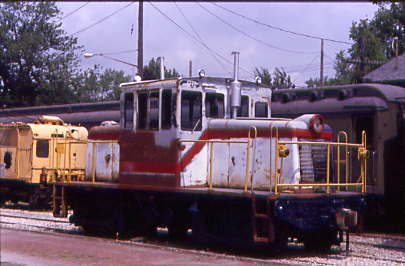
France Stone Company 45 ton switcher 1776/1976 built by General Electric.
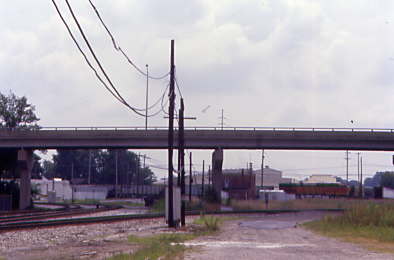
I heard a freight horn and caught a train out on the Norfolk Southern mainline. It was then time to visit the interior of the museum and the grounds and I paid with another coupon from the 2006 Tourist Trains book. I was given a wristband to allow me to enter across the street and I started my tour of the museum in Room B.
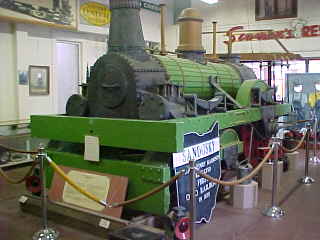
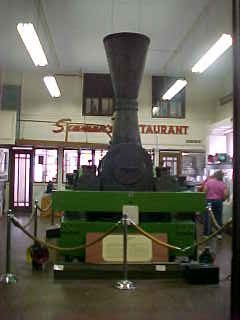
A replica of the 4-2-0 Sandusky, the original of which was built by Rogers in 1837 and was the first locomotive in Ohio.
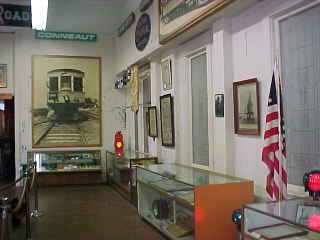
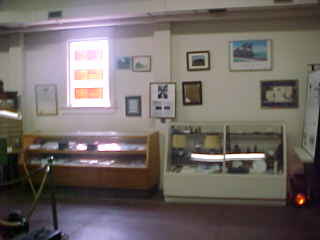
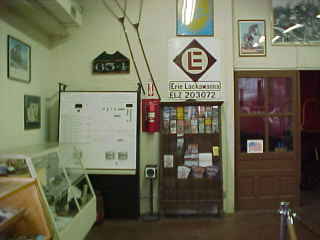
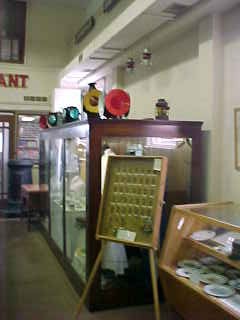
Interior of Room B, after which I entered Room C.
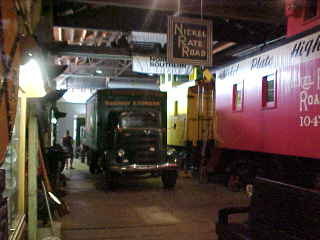
A 1929 Ford truck used by the Railway Express Agency.

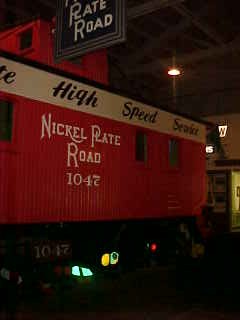
Nickel Plate wooden caboose 1047 built by the railroad in 1882.

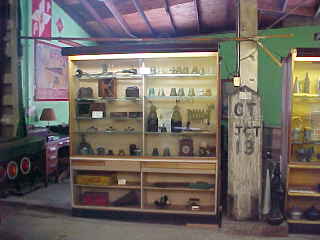
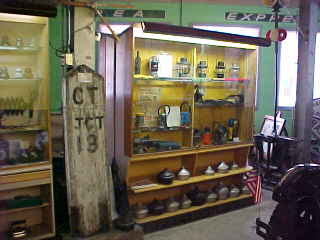
Displays in Room C. I then walked into the newest area of the museum housing four unique passenger cars.
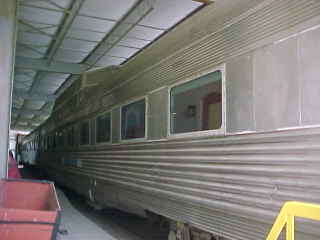
Chicago, Burlington and Quincy 4714 "Silver Dome", the first dome car built in the United States used on the Train of Tomorrow. It was built by Budd in 1940 as Chicago, Burlington and Quincy coach 4714 "Silver Alchemy" and was converted to a dome car in 1945.
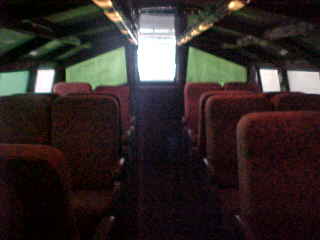
Interior of "Silver Dome".
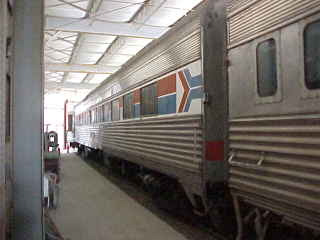
Amtrak dining car 8002, nee Seaboard Air Line 6102, built by Budd Company in 1939.

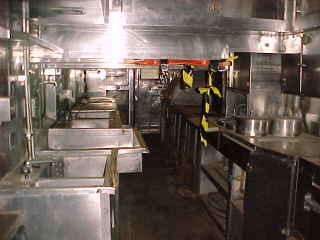
Interior of the dining car.

Nickel Plate Road coach 105 built by Pullman Standard in 1950.
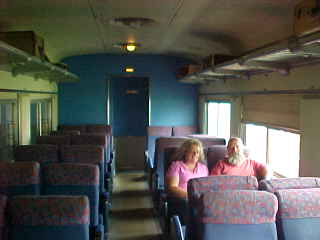

The interior of the coach, with two visitors, Greg and Deb, enjoying their experience.
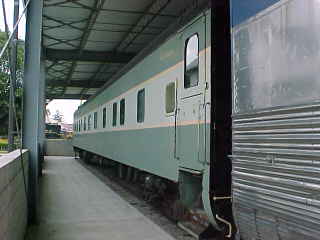
Pullman 6-6-4 sleeper "American Life", sold to Erie Railroad and became Erie 6 "American Life", built by Pullman Standard in 1942.
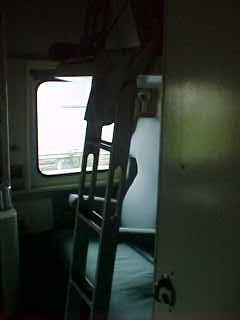
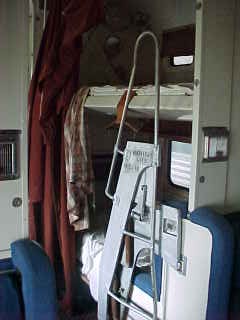
The ladder and berths made up.
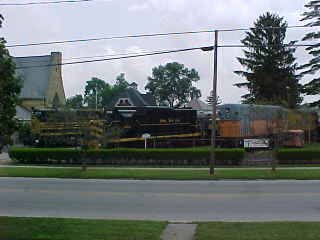
The view from the passenger cars across the street to the other part of the museum.
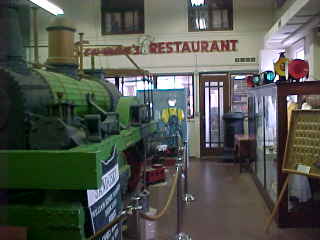
I returned to Room B.

I went through Room A to exit this part of the museum to cross the street.
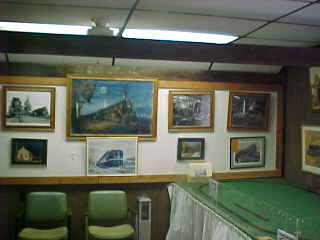


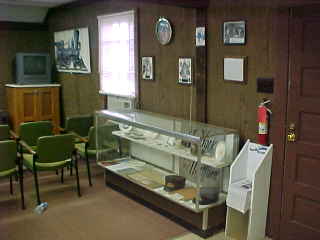
One enters this part of the museum by going through the Lake Shore and Michigan Southern (New York Central) section house. I then went for more equipment.
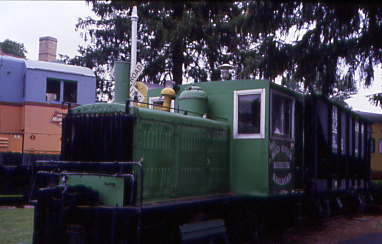
Mad River Railroad Museum 18 ton switcher 76, formerly owned by Aloca Aluminium Company, built by Plymouth in 1926.
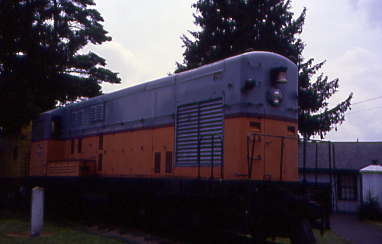
Milwaukee Road H12-44 740, nee Milwaukee Road 2322, built by Fairbanks Morse in 1954.

Nickel Plate Road GP30 900.
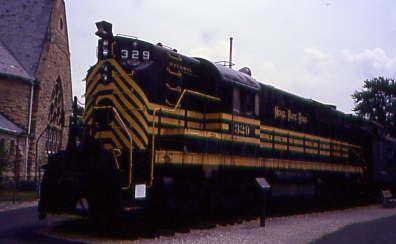
Nickel Plate Road RSD12 329.
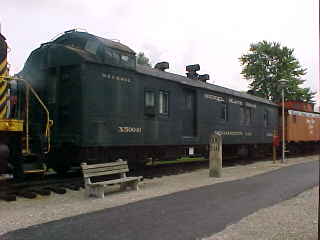
Nickel Plate Road Dynamometer Car 50041 built by Standard Steel in 1924.
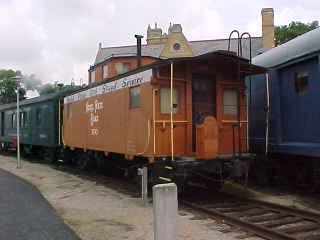
Wheeling and Lake Erie caboose 200 built by the railroad in 1948 and painted as Nickel Plate 700.
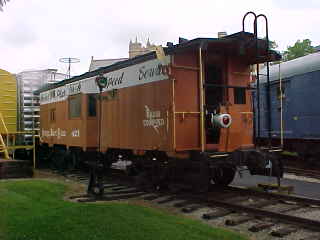
Nickel Plate Road bay window caboose 423 built by the railroad in 1956.
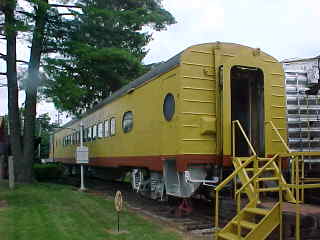
Milwaukee Road 52 seat coach 618, nee Milwaukee Road 531, built by the railroad in 1948.
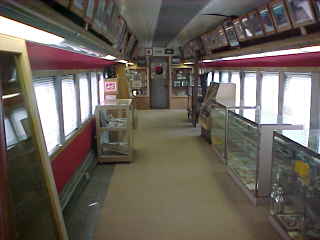
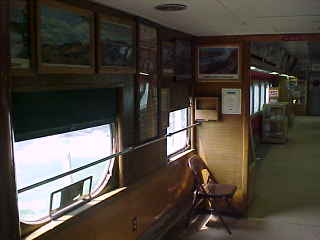
Interior of the coach.
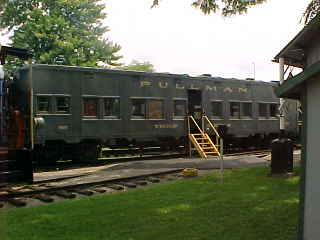
Troop Sleeper 7407 built by Pullman in 1943.
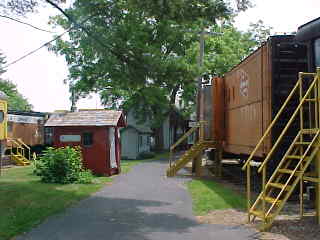
Museum scene.
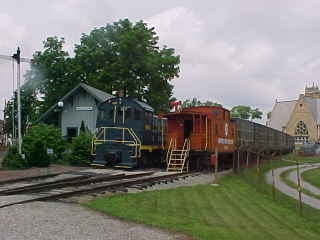
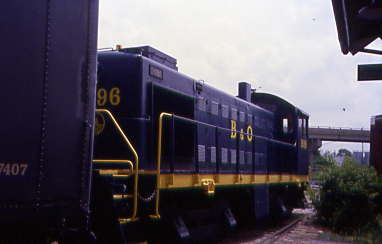
Baltimore and Ohio S-4 9096 built by American Locomotive Company in 1956 and Norfolk and Western steel caboose 518397 built by the railroad in 1927.
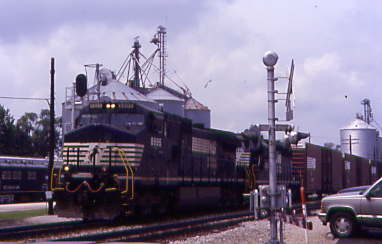
Norfolk Southern 8895 East passed the museum.
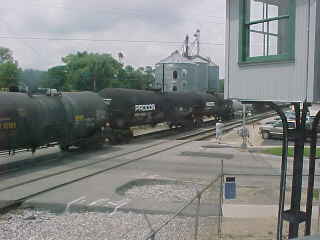
Chris Parker videotaping the freight train from inside Wabash F7A 671.
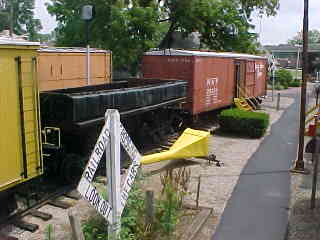
Nickel Plate Road gondola car 70130 built by Standard Steel in 1923.
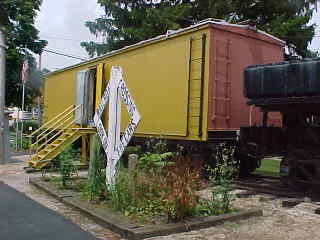
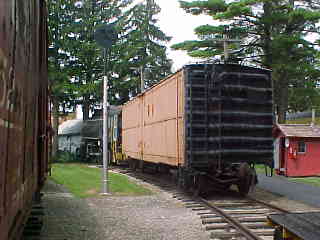
Union Refrigerator Transit Company 50 foot refrigerator car 37351 built by General American in 1948 and leased to Milwaukee Road.
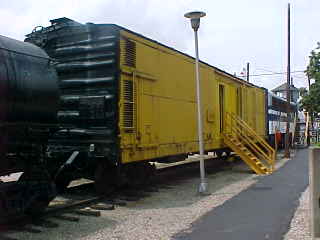
Milwaukee Road Metal Reefer URTX 31003 built by General American in 1945.

Toledo, Angola and Western tank car built in 1942.
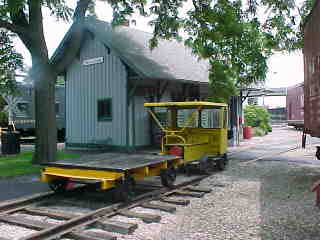
The Wheeling and Lake Erie depot from Curtice, Ohio built in 1882 and moved to the museum grounds.
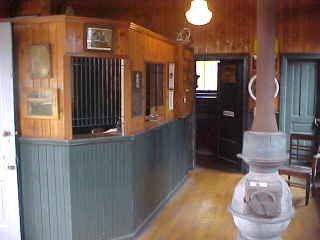
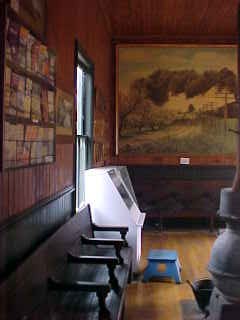
Interior of the depot.
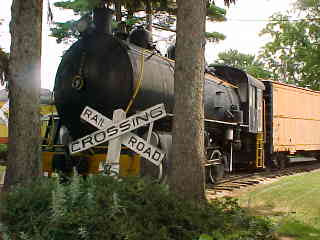
Cleveland Electric Illuminating 0-6-0F 7 built by H.K. Porter in 1943.
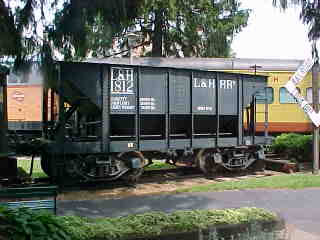
Nickel Plate Road gondola car 70130 built by Standard Steel in 1923.
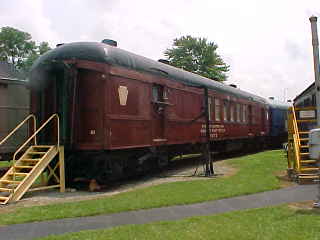
Pennsylvania Railroad (United States Mail Railway) Post Office Car 6570 built by the railroad in 1911.
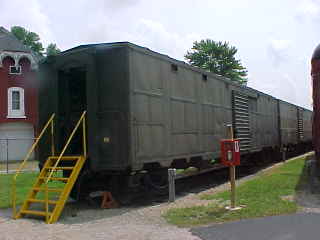
Former troop sleepers convererted into box cars containing the TSCX collection of Ted and Sarah Church of Erie, Pennsylvania.
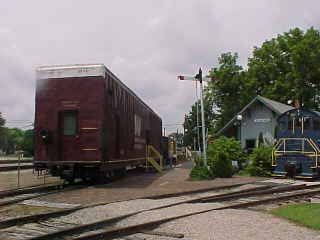
Norfolk and Western Railroad Safety and Mechanical Instruction Car 401, formerly an auto parts carrying car.
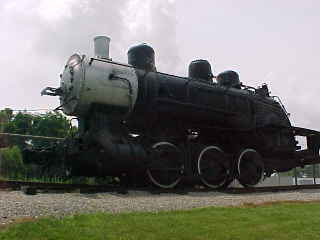
Mad River and NKP Museum 0-4-2T 1, ex. Keith Mason 1976, exx. B.J. Pollard 1965, exxx. Maddox Foundry and Machine Works Incorported in Archer, Florida, nee Cameron & Barclay 0-4-2T 1 built by Baldwin Locomotive Works in 1890.
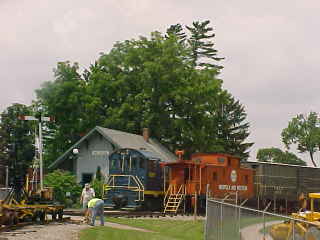
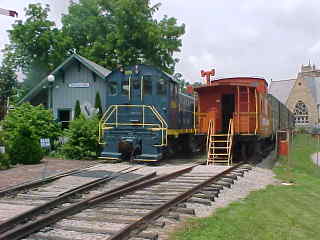
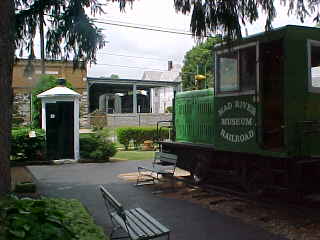
Museum views.
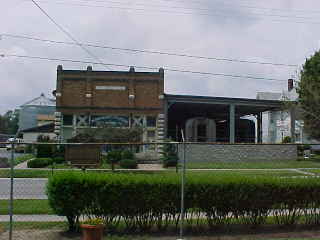
Looking across Southwest Street towards the "Silver Dome". This ended our tour of the Mad River & NKP Museum. After I bought some postcards and thanked the members of this fine museum, I met Chris Parker in the parking lot and we drove over to Bellevue Tower at the Norfolk Southern junction of several lines.
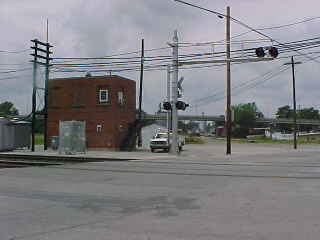
Bellevue Tower, which was originally maintained by the Pennsylvania Railroad and staffed by both PRR and Wheeling and Lake Erie. It was used to control movements in and out of the west end of Nickel Plate's Bellevue Yard. It controlled the W&LE crossing, the Pennsylvania Railroad crossing and also the New York Central Norwalk Branch crossing. While the New York Central line was removed in 1976 prior to Conrail's formation, the Wheeling and Lake Erie diamonds were removed in the 1980's in favor of the Brewster Connection.
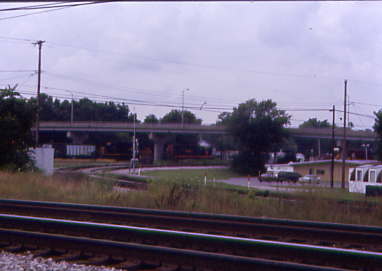
A Wheeling and Lake Erie train made its wya north out of Bellevue.
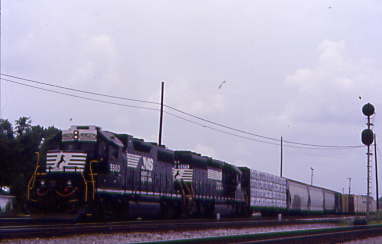
Norfolk Southern 5560 West.
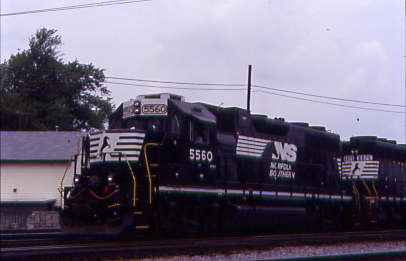
Norfolk Southern GP38-2 5560, nee Norfolk and Western GP38AC 4149, built by Electro-Motive Division in 1971. Chris and I were both hungry after that great visit, so we stopped at Wendy's for Chris and A&W for me on the way out of town. We had one more stop to make, if we had time, on our way back to New Philadelphia so took US 250 east and south of Savannah, spotted a CSX train stopped on their mainline. We zigzagged the crossing to get close enough for a picture then climbed and walked the side of a reservoir.
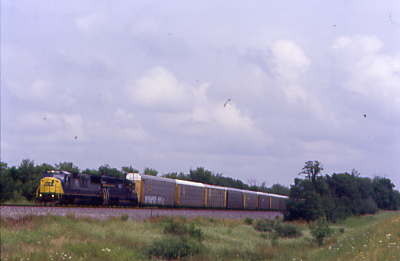
CSXT 6772 West stopped dead on the mainline. Back on US 250, we avoided rain showers as we continued our trek. As we passed through Apple Tree, I spotted an Amish horse and buggy and directed Chris onto a side road and he was now a happy Chris, but still wanted more. We drove out of Apple Tree and I started seeing "horse droppings" along the road.
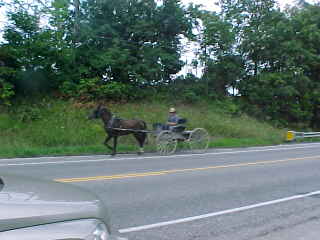
We drove over a hill and guess what we saw coming the other way - an Amish horse and buggy. A non-covered buggy means the male driver is single. Over the next few miles, we had four more buggies which Chris videotaped as he drove with a big smile on his face. My favorite moment was in Mt. Eaton when we stopped at a red light. First a truck went through on the green light, followed very quickly by another Amish horse and buggy. After Mt. Eaton, we passed through a rain shower as we turned onto Interstate 77 before stopping at the Warthers Carving Museum in Dover.
| RETURN TO THE MAIN PAGE |